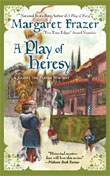CHAPTER 2
He was shortly overtaken by a trotting line of pack-horses, their rope-bound bundles strapped firmly to backs and sides. Their rider at lead did not give him so much as a look, but Joliffe and the rear man shared friendly nods as they passed. The titupping of hoofs faded, the rain gave up, and for a time Joliffe was alone on the road again, except companioned now by regret at how much of ease was gone from his day. He had been looking forward to being simply a player in Coventry. Now he was supposed to find out what he could about this Master Kydwa. And Lollards…
Near the beginning of the outline for A Play of Heresy, Joliffe, having parted company with his fellow-spy, “goes on, alone again, into Coventry. He finds Basset and the others…” There. Done. Joliffe arrives in Coventry; Joliffe finds his friends; now we can get on with murdering people. Simple enough, yes?
Or not.
In a story set in a modern setting much can go unsaid. “He pulled up outside the motel office where ‘Vacancy’ glowed in the window.” That’s all understandable enough to a modern reader. But “arrives in Coventry” – and medieval Coventry at that – conveys no real sense of place. Those bald words contain no sense of what Joliffe actually experiences in arriving there in 1438. So, as the author, I have to make Coventry happen for the reader right along with Joliffe, and that simple statement in the outline — “Joliffe goes into Coventry” — led to my digging into my files folders for photos, maps, and descriptions of Coventry that I had accumulated over the years, plus accessing my memories of several visits there, plus finding a wonderful site online that amplified and clarified much I already had.
Every bit of all that was then distilled into a few paragraphs of description mixed with action, as Joliffe arrived in Coventry by way of the Warwick road. Such are the delightful travails of research – much learned so it can be refined down to precisely the little needed in the story itself. But without the much, a writer can’t be sure exactly what little is needed.
Of course threaded through the whole story, as Joliffe wanders the town in search of secrets and truths, are more details about Coventry. Drawn from all those maps and photos and descriptions, they help to build a picture of a thriving town full of proud, prosperous citizens – an everyday setting of normal lives into which the story’s deceptions and murders are woven. To this day, after all the time I’ve spent “walking through Coventry” with Joliffe, I have the nagging suspicion that, if I had to, I could now find my way in medieval Coventry fairly handily.
But of course there’s nearly nothing of medieval Coventry left for us to wander in for real. Unlike many towns that still have their medieval streets, Coventry’s medieval heart is gone, bombed and burned along with its cathedral during World War II and afterward rebuilt to meet more modern needs. Only in our imaginations, drawing on what facts remain, can we still wander there. But that’s what historical novelists should delight in doing – helping us to walk where otherwise we never could, because that’s one of the reasons we read historical novels, right? To experience another place in another time, where otherwise we could never go.
I, at least, greatly enjoyed my time in medieval Coventry and deeply hope that you will, too.
– Margaret
Follow the virtual bookclub for A Play of Heresy on Facebook and Twitter.
















